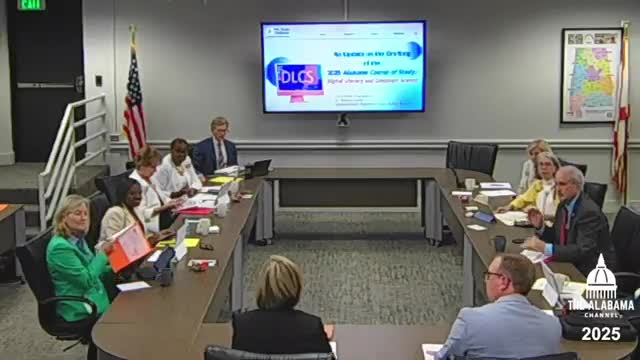State task force updates draft digital‑literacy, computer‑science course of study; AI embedded across grade bands
October 18, 2025 | Alabama State Department of Education, State Agencies, Executive, Alabama
This article was created by AI summarizing key points discussed. AI makes mistakes, so for full details and context, please refer to the video of the full meeting. Please report any errors so we can fix them. Report an error »

State education staff and committee members reported progress on the 2025 digital‑literacy and computer‑science course of study, describing a work plan that embeds artificial intelligence (AI), cybersecurity, digital citizenship and computational thinking across grade bands.
Why it matters: The course of study will set statewide learning expectations for K‑12 teachers and guide professional development and instructional materials.
Committee work and themes: Superintendent and committee member Michelle Collier (Escambia County) said the review revisited the 2018 standards, compared other states’ frameworks and emphasized forward‑looking skills. Committee leaders identified core strands including computational thinking, computing systems, data science, digital proficiency and digital citizenship.
“Project‑based learning” and hands‑on, age‑appropriate activities were repeatedly cited by committee members and by students in the earlier panel as the preferred instructional model. Committee staff said AI will be flagged throughout the document with an “AI” indicator to show progression of understanding from K‑2 through 12th grade; the team is emphasizing ethical use, prompt‑building and how to sequence follow‑up questions when using AI tools.
Timeline and public input: Staff reported more than 90 expert reviewers signed up to provide feedback on the draft. The department plans an August 1 release of the draft for formal public comment, with comment incorporation in October, a November work session for the board, and the standard December vote timeline to place the course of study on the board agenda.
Industry review and flexibility: Board members asked whether industry reviewers were included; staff said universities and K‑12 teachers are well represented among the 90 reviewers and that industry participation is being reviewed. Committee members emphasized that the course will focus on task‑oriented skills (for example: problem solving, debugging, data literacy) rather than naming specific commercial tools, allowing flexibility as devices and platforms evolve.
Next steps: Staff said they will continue virtual meetings through the summer, finalize the draft for August public comment and incorporate feedback ahead of the November board review. They also flagged professional development plans to support teacher competency in AI and cybersecurity.
Ending: Officials asked board members to forward suggestions and potential reviewers to the department ahead of the public comment window.
Why it matters: The course of study will set statewide learning expectations for K‑12 teachers and guide professional development and instructional materials.
Committee work and themes: Superintendent and committee member Michelle Collier (Escambia County) said the review revisited the 2018 standards, compared other states’ frameworks and emphasized forward‑looking skills. Committee leaders identified core strands including computational thinking, computing systems, data science, digital proficiency and digital citizenship.
“Project‑based learning” and hands‑on, age‑appropriate activities were repeatedly cited by committee members and by students in the earlier panel as the preferred instructional model. Committee staff said AI will be flagged throughout the document with an “AI” indicator to show progression of understanding from K‑2 through 12th grade; the team is emphasizing ethical use, prompt‑building and how to sequence follow‑up questions when using AI tools.
Timeline and public input: Staff reported more than 90 expert reviewers signed up to provide feedback on the draft. The department plans an August 1 release of the draft for formal public comment, with comment incorporation in October, a November work session for the board, and the standard December vote timeline to place the course of study on the board agenda.
Industry review and flexibility: Board members asked whether industry reviewers were included; staff said universities and K‑12 teachers are well represented among the 90 reviewers and that industry participation is being reviewed. Committee members emphasized that the course will focus on task‑oriented skills (for example: problem solving, debugging, data literacy) rather than naming specific commercial tools, allowing flexibility as devices and platforms evolve.
Next steps: Staff said they will continue virtual meetings through the summer, finalize the draft for August public comment and incorporate feedback ahead of the November board review. They also flagged professional development plans to support teacher competency in AI and cybersecurity.
Ending: Officials asked board members to forward suggestions and potential reviewers to the department ahead of the public comment window.
View full meeting
This article is based on a recent meeting—watch the full video and explore the complete transcript for deeper insights into the discussion.
View full meeting
